Critical Thinking Essay: Case Study on End-of-Life Kidney Disease
VerifiedAdded on 2022/09/11
|8
|1768
|14
Essay
AI Summary
This essay presents a critical analysis of a case study involving an obese 32-year-old male patient experiencing end-of-life kidney disease. The essay begins with an introduction that highlights the global burden of chronic kidney disease (CKD) and obesity's role as a significant risk factor. The discussion section delves into the patient's clinical manifestations, including high blood pressure, dysphonia, swollen ankles, sleep apnea, and pruritus, along with relevant objective data such as fasting blood glucose, blood pressure, respiratory rate, and serum creatinine levels. The essay explores the health risks associated with obesity, such as heart disease, stroke, and diabetes, and discusses the potential benefits of bariatric surgery for weight loss and improved kidney function. It further examines the patient's functional health patterns, including health management, nutritional habits, metabolic function, and activity levels, and details the stage of end-of-life kidney disease. The essay then provides recommendations for patient education, including audiovisual methods for health literacy, dietary modifications, and post-operative care. It also suggests resources such as the National Kidney Foundation and the support of a multidisciplinary team. The conclusion summarizes the key findings and emphasizes the importance of early intervention and comprehensive patient care. References are provided to support the essay's claims.
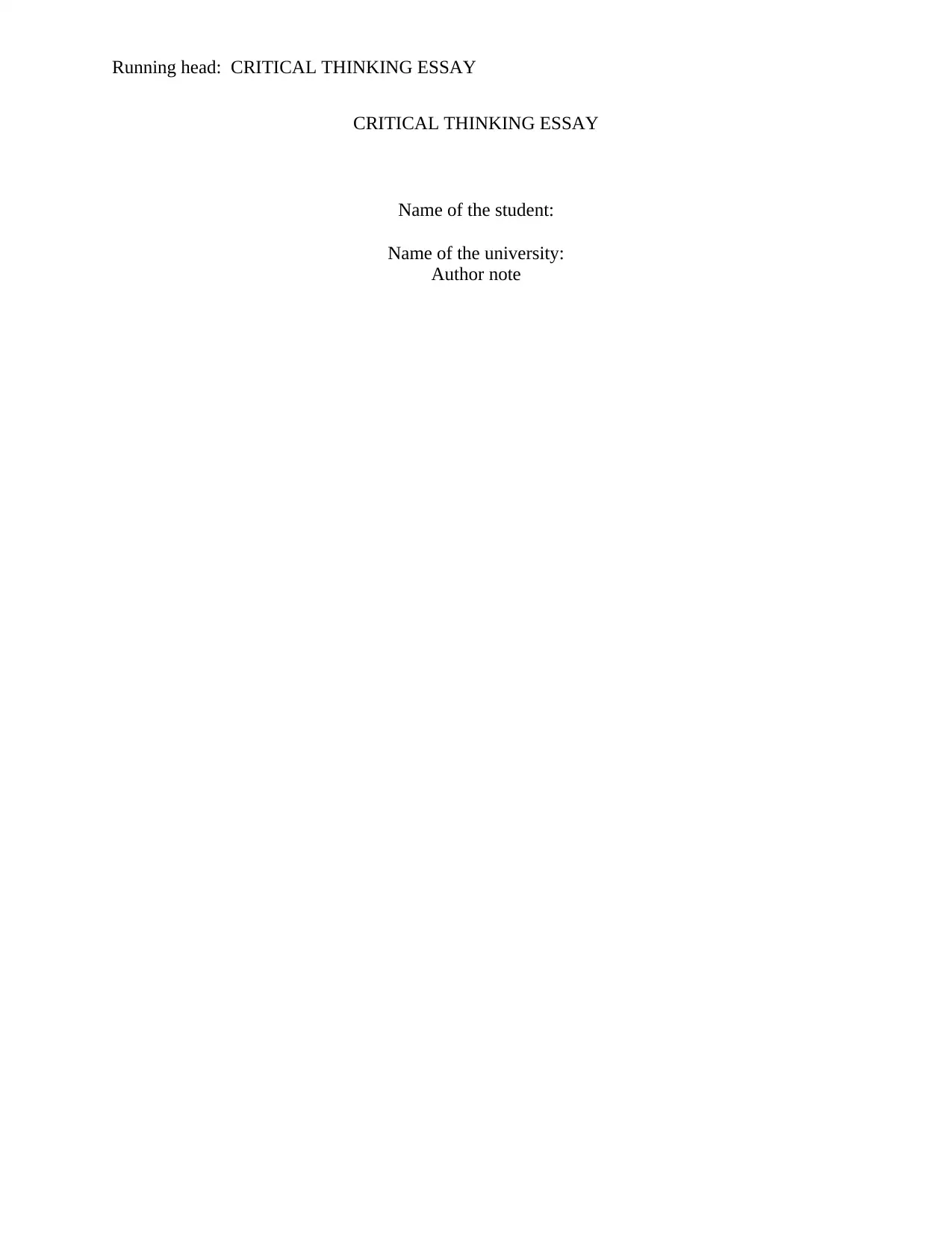
Running head: CRITICAL THINKING ESSAY
CRITICAL THINKING ESSAY
Name of the student:
Name of the university:
Author note
CRITICAL THINKING ESSAY
Name of the student:
Name of the university:
Author note
Paraphrase This Document
Need a fresh take? Get an instant paraphrase of this document with our AI Paraphraser
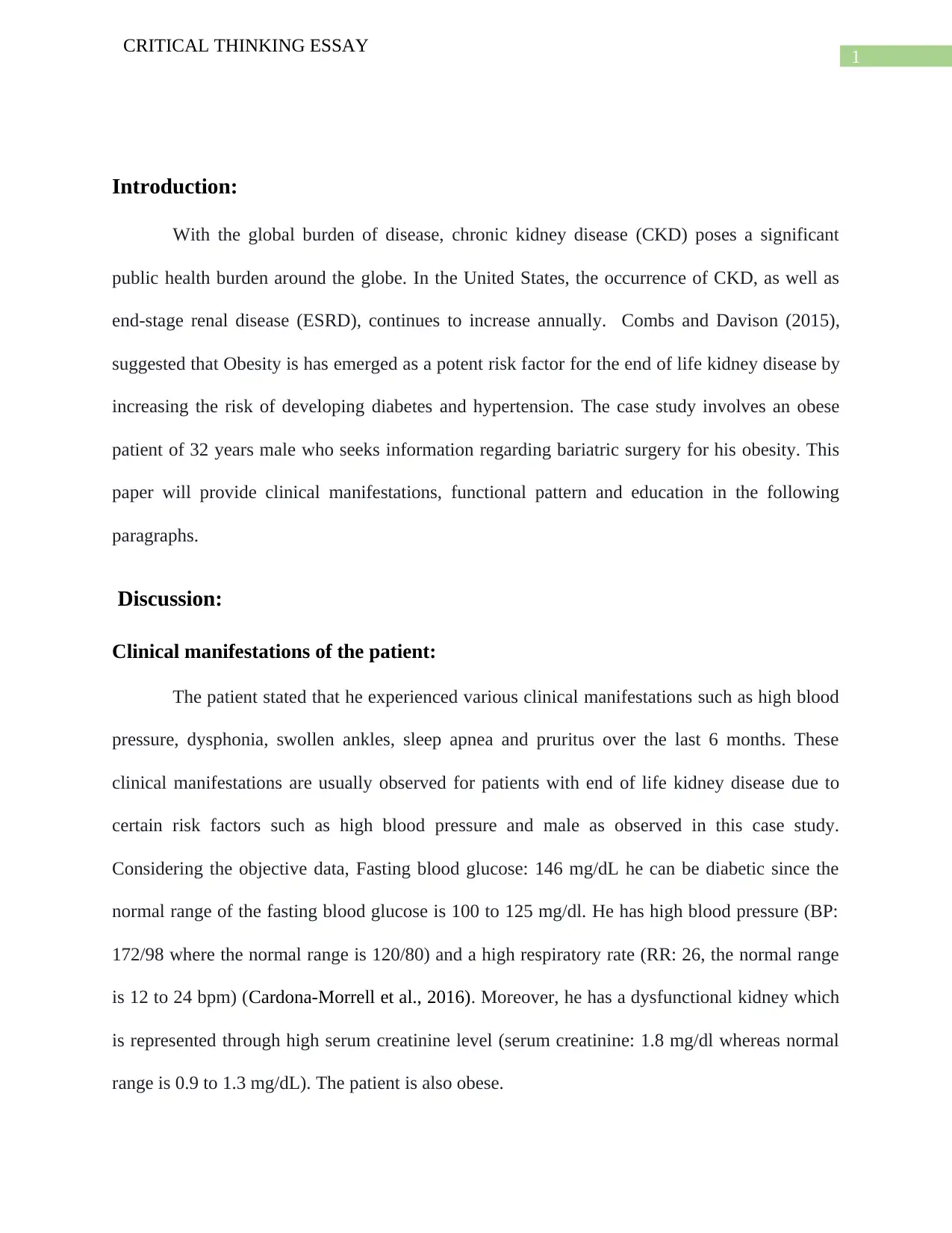
1
CRITICAL THINKING ESSAY
Introduction:
With the global burden of disease, chronic kidney disease (CKD) poses a significant
public health burden around the globe. In the United States, the occurrence of CKD, as well as
end-stage renal disease (ESRD), continues to increase annually. Combs and Davison (2015),
suggested that Obesity is has emerged as a potent risk factor for the end of life kidney disease by
increasing the risk of developing diabetes and hypertension. The case study involves an obese
patient of 32 years male who seeks information regarding bariatric surgery for his obesity. This
paper will provide clinical manifestations, functional pattern and education in the following
paragraphs.
Discussion:
Clinical manifestations of the patient:
The patient stated that he experienced various clinical manifestations such as high blood
pressure, dysphonia, swollen ankles, sleep apnea and pruritus over the last 6 months. These
clinical manifestations are usually observed for patients with end of life kidney disease due to
certain risk factors such as high blood pressure and male as observed in this case study.
Considering the objective data, Fasting blood glucose: 146 mg/dL he can be diabetic since the
normal range of the fasting blood glucose is 100 to 125 mg/dl. He has high blood pressure (BP:
172/98 where the normal range is 120/80) and a high respiratory rate (RR: 26, the normal range
is 12 to 24 bpm) (Cardona-Morrell et al., 2016). Moreover, he has a dysfunctional kidney which
is represented through high serum creatinine level (serum creatinine: 1.8 mg/dl whereas normal
range is 0.9 to 1.3 mg/dL). The patient is also obese.
CRITICAL THINKING ESSAY
Introduction:
With the global burden of disease, chronic kidney disease (CKD) poses a significant
public health burden around the globe. In the United States, the occurrence of CKD, as well as
end-stage renal disease (ESRD), continues to increase annually. Combs and Davison (2015),
suggested that Obesity is has emerged as a potent risk factor for the end of life kidney disease by
increasing the risk of developing diabetes and hypertension. The case study involves an obese
patient of 32 years male who seeks information regarding bariatric surgery for his obesity. This
paper will provide clinical manifestations, functional pattern and education in the following
paragraphs.
Discussion:
Clinical manifestations of the patient:
The patient stated that he experienced various clinical manifestations such as high blood
pressure, dysphonia, swollen ankles, sleep apnea and pruritus over the last 6 months. These
clinical manifestations are usually observed for patients with end of life kidney disease due to
certain risk factors such as high blood pressure and male as observed in this case study.
Considering the objective data, Fasting blood glucose: 146 mg/dL he can be diabetic since the
normal range of the fasting blood glucose is 100 to 125 mg/dl. He has high blood pressure (BP:
172/98 where the normal range is 120/80) and a high respiratory rate (RR: 26, the normal range
is 12 to 24 bpm) (Cardona-Morrell et al., 2016). Moreover, he has a dysfunctional kidney which
is represented through high serum creatinine level (serum creatinine: 1.8 mg/dl whereas normal
range is 0.9 to 1.3 mg/dL). The patient is also obese.
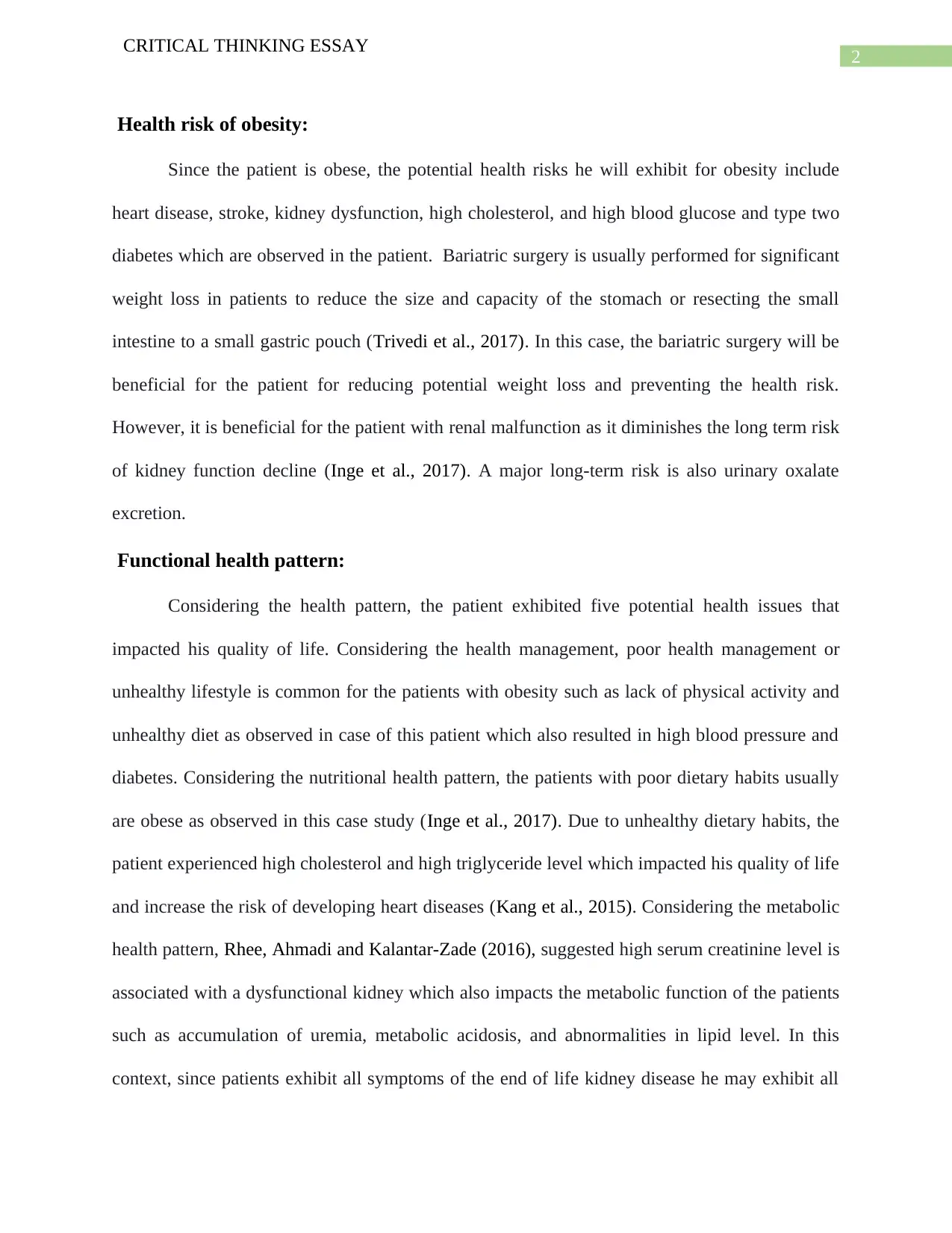
2
CRITICAL THINKING ESSAY
Health risk of obesity:
Since the patient is obese, the potential health risks he will exhibit for obesity include
heart disease, stroke, kidney dysfunction, high cholesterol, and high blood glucose and type two
diabetes which are observed in the patient. Bariatric surgery is usually performed for significant
weight loss in patients to reduce the size and capacity of the stomach or resecting the small
intestine to a small gastric pouch (Trivedi et al., 2017). In this case, the bariatric surgery will be
beneficial for the patient for reducing potential weight loss and preventing the health risk.
However, it is beneficial for the patient with renal malfunction as it diminishes the long term risk
of kidney function decline (Inge et al., 2017). A major long-term risk is also urinary oxalate
excretion.
Functional health pattern:
Considering the health pattern, the patient exhibited five potential health issues that
impacted his quality of life. Considering the health management, poor health management or
unhealthy lifestyle is common for the patients with obesity such as lack of physical activity and
unhealthy diet as observed in case of this patient which also resulted in high blood pressure and
diabetes. Considering the nutritional health pattern, the patients with poor dietary habits usually
are obese as observed in this case study (Inge et al., 2017). Due to unhealthy dietary habits, the
patient experienced high cholesterol and high triglyceride level which impacted his quality of life
and increase the risk of developing heart diseases (Kang et al., 2015). Considering the metabolic
health pattern, Rhee, Ahmadi and Kalantar-Zade (2016), suggested high serum creatinine level is
associated with a dysfunctional kidney which also impacts the metabolic function of the patients
such as accumulation of uremia, metabolic acidosis, and abnormalities in lipid level. In this
context, since patients exhibit all symptoms of the end of life kidney disease he may exhibit all
CRITICAL THINKING ESSAY
Health risk of obesity:
Since the patient is obese, the potential health risks he will exhibit for obesity include
heart disease, stroke, kidney dysfunction, high cholesterol, and high blood glucose and type two
diabetes which are observed in the patient. Bariatric surgery is usually performed for significant
weight loss in patients to reduce the size and capacity of the stomach or resecting the small
intestine to a small gastric pouch (Trivedi et al., 2017). In this case, the bariatric surgery will be
beneficial for the patient for reducing potential weight loss and preventing the health risk.
However, it is beneficial for the patient with renal malfunction as it diminishes the long term risk
of kidney function decline (Inge et al., 2017). A major long-term risk is also urinary oxalate
excretion.
Functional health pattern:
Considering the health pattern, the patient exhibited five potential health issues that
impacted his quality of life. Considering the health management, poor health management or
unhealthy lifestyle is common for the patients with obesity such as lack of physical activity and
unhealthy diet as observed in case of this patient which also resulted in high blood pressure and
diabetes. Considering the nutritional health pattern, the patients with poor dietary habits usually
are obese as observed in this case study (Inge et al., 2017). Due to unhealthy dietary habits, the
patient experienced high cholesterol and high triglyceride level which impacted his quality of life
and increase the risk of developing heart diseases (Kang et al., 2015). Considering the metabolic
health pattern, Rhee, Ahmadi and Kalantar-Zade (2016), suggested high serum creatinine level is
associated with a dysfunctional kidney which also impacts the metabolic function of the patients
such as accumulation of uremia, metabolic acidosis, and abnormalities in lipid level. In this
context, since patients exhibit all symptoms of the end of life kidney disease he may exhibit all
⊘ This is a preview!⊘
Do you want full access?
Subscribe today to unlock all pages.

Trusted by 1+ million students worldwide
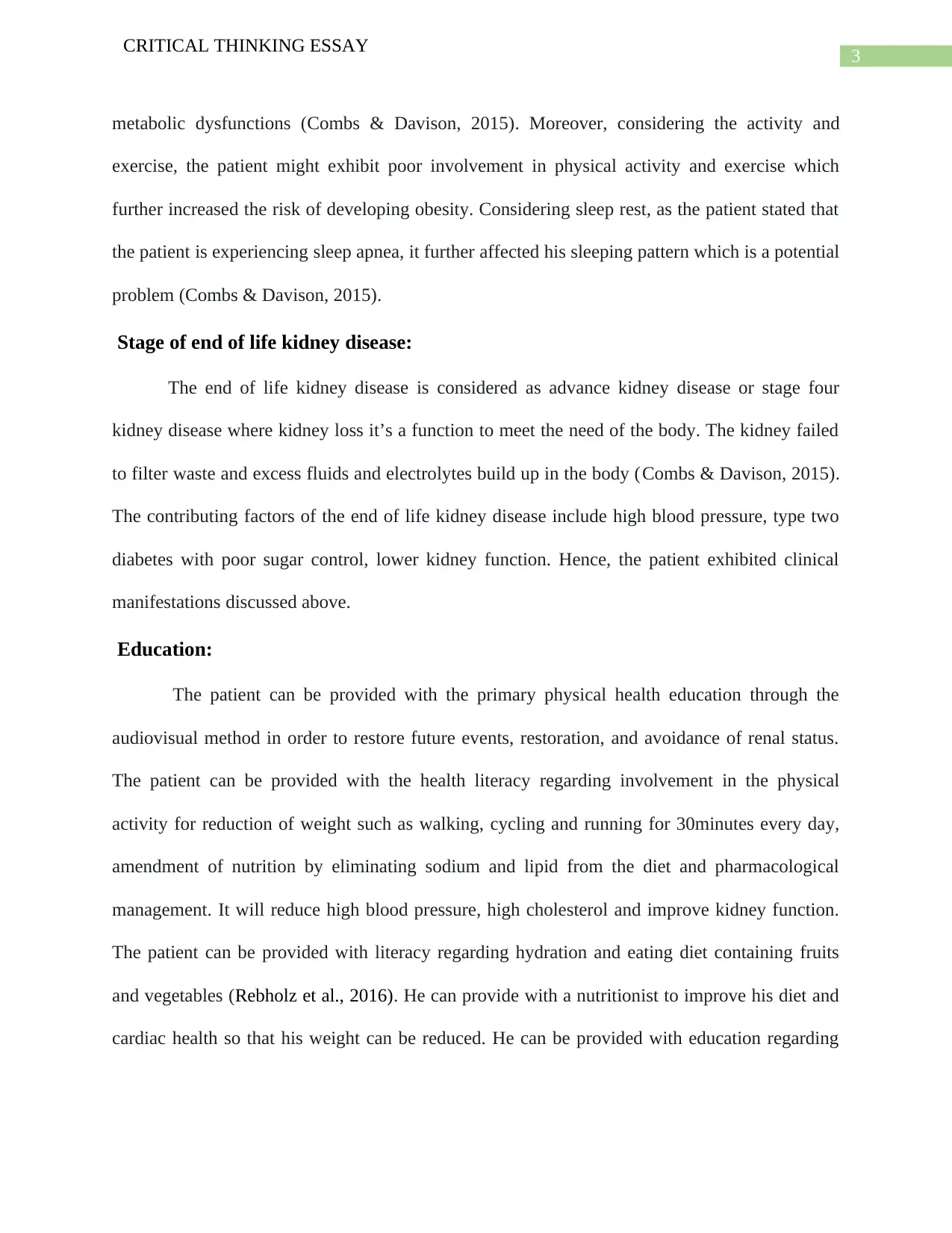
3
CRITICAL THINKING ESSAY
metabolic dysfunctions (Combs & Davison, 2015). Moreover, considering the activity and
exercise, the patient might exhibit poor involvement in physical activity and exercise which
further increased the risk of developing obesity. Considering sleep rest, as the patient stated that
the patient is experiencing sleep apnea, it further affected his sleeping pattern which is a potential
problem (Combs & Davison, 2015).
Stage of end of life kidney disease:
The end of life kidney disease is considered as advance kidney disease or stage four
kidney disease where kidney loss it’s a function to meet the need of the body. The kidney failed
to filter waste and excess fluids and electrolytes build up in the body (Combs & Davison, 2015).
The contributing factors of the end of life kidney disease include high blood pressure, type two
diabetes with poor sugar control, lower kidney function. Hence, the patient exhibited clinical
manifestations discussed above.
Education:
The patient can be provided with the primary physical health education through the
audiovisual method in order to restore future events, restoration, and avoidance of renal status.
The patient can be provided with the health literacy regarding involvement in the physical
activity for reduction of weight such as walking, cycling and running for 30minutes every day,
amendment of nutrition by eliminating sodium and lipid from the diet and pharmacological
management. It will reduce high blood pressure, high cholesterol and improve kidney function.
The patient can be provided with literacy regarding hydration and eating diet containing fruits
and vegetables (Rebholz et al., 2016). He can provide with a nutritionist to improve his diet and
cardiac health so that his weight can be reduced. He can be provided with education regarding
CRITICAL THINKING ESSAY
metabolic dysfunctions (Combs & Davison, 2015). Moreover, considering the activity and
exercise, the patient might exhibit poor involvement in physical activity and exercise which
further increased the risk of developing obesity. Considering sleep rest, as the patient stated that
the patient is experiencing sleep apnea, it further affected his sleeping pattern which is a potential
problem (Combs & Davison, 2015).
Stage of end of life kidney disease:
The end of life kidney disease is considered as advance kidney disease or stage four
kidney disease where kidney loss it’s a function to meet the need of the body. The kidney failed
to filter waste and excess fluids and electrolytes build up in the body (Combs & Davison, 2015).
The contributing factors of the end of life kidney disease include high blood pressure, type two
diabetes with poor sugar control, lower kidney function. Hence, the patient exhibited clinical
manifestations discussed above.
Education:
The patient can be provided with the primary physical health education through the
audiovisual method in order to restore future events, restoration, and avoidance of renal status.
The patient can be provided with the health literacy regarding involvement in the physical
activity for reduction of weight such as walking, cycling and running for 30minutes every day,
amendment of nutrition by eliminating sodium and lipid from the diet and pharmacological
management. It will reduce high blood pressure, high cholesterol and improve kidney function.
The patient can be provided with literacy regarding hydration and eating diet containing fruits
and vegetables (Rebholz et al., 2016). He can provide with a nutritionist to improve his diet and
cardiac health so that his weight can be reduced. He can be provided with education regarding
Paraphrase This Document
Need a fresh take? Get an instant paraphrase of this document with our AI Paraphraser
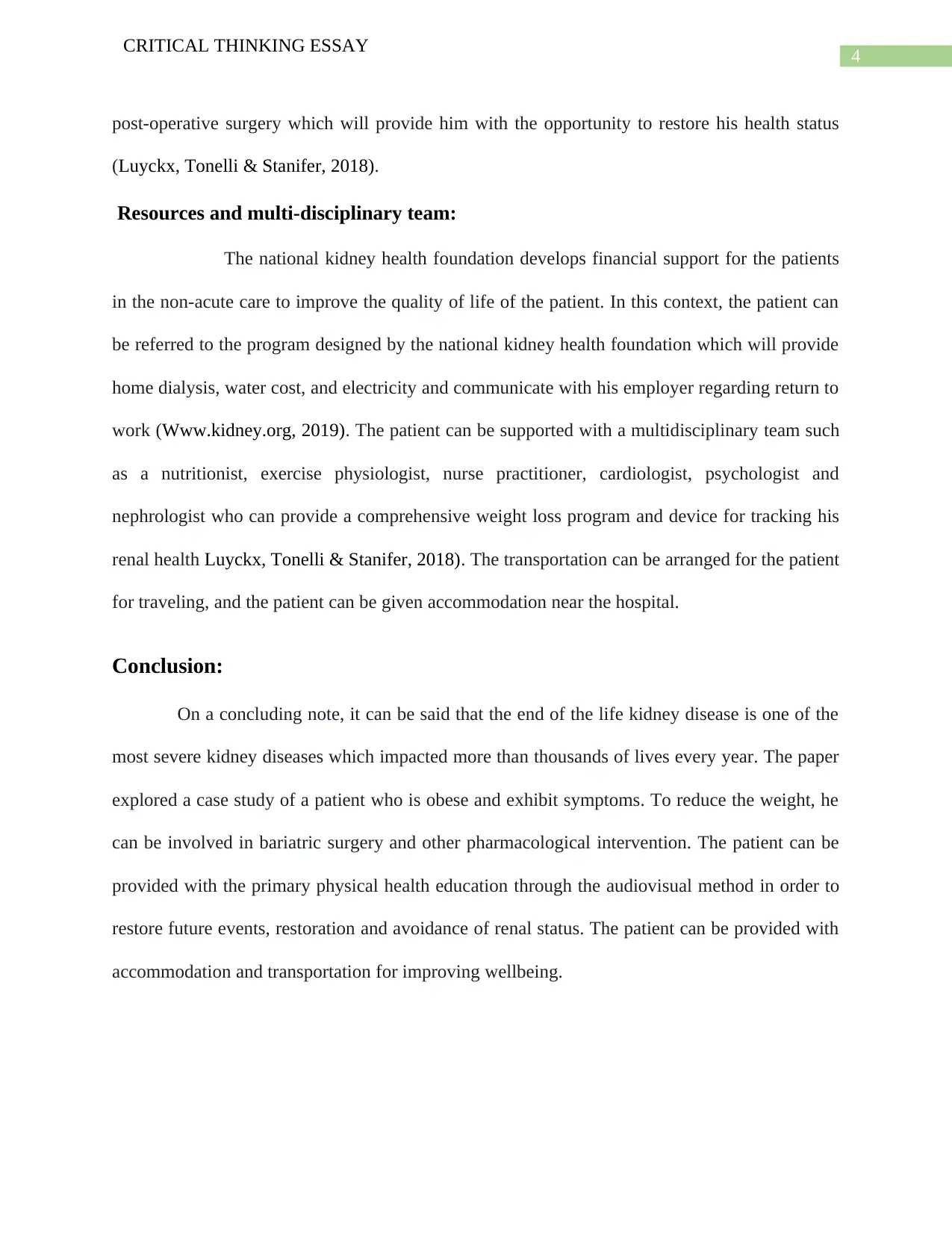
4
CRITICAL THINKING ESSAY
post-operative surgery which will provide him with the opportunity to restore his health status
(Luyckx, Tonelli & Stanifer, 2018).
Resources and multi-disciplinary team:
The national kidney health foundation develops financial support for the patients
in the non-acute care to improve the quality of life of the patient. In this context, the patient can
be referred to the program designed by the national kidney health foundation which will provide
home dialysis, water cost, and electricity and communicate with his employer regarding return to
work (Www.kidney.org, 2019). The patient can be supported with a multidisciplinary team such
as a nutritionist, exercise physiologist, nurse practitioner, cardiologist, psychologist and
nephrologist who can provide a comprehensive weight loss program and device for tracking his
renal health Luyckx, Tonelli & Stanifer, 2018). The transportation can be arranged for the patient
for traveling, and the patient can be given accommodation near the hospital.
Conclusion:
On a concluding note, it can be said that the end of the life kidney disease is one of the
most severe kidney diseases which impacted more than thousands of lives every year. The paper
explored a case study of a patient who is obese and exhibit symptoms. To reduce the weight, he
can be involved in bariatric surgery and other pharmacological intervention. The patient can be
provided with the primary physical health education through the audiovisual method in order to
restore future events, restoration and avoidance of renal status. The patient can be provided with
accommodation and transportation for improving wellbeing.
CRITICAL THINKING ESSAY
post-operative surgery which will provide him with the opportunity to restore his health status
(Luyckx, Tonelli & Stanifer, 2018).
Resources and multi-disciplinary team:
The national kidney health foundation develops financial support for the patients
in the non-acute care to improve the quality of life of the patient. In this context, the patient can
be referred to the program designed by the national kidney health foundation which will provide
home dialysis, water cost, and electricity and communicate with his employer regarding return to
work (Www.kidney.org, 2019). The patient can be supported with a multidisciplinary team such
as a nutritionist, exercise physiologist, nurse practitioner, cardiologist, psychologist and
nephrologist who can provide a comprehensive weight loss program and device for tracking his
renal health Luyckx, Tonelli & Stanifer, 2018). The transportation can be arranged for the patient
for traveling, and the patient can be given accommodation near the hospital.
Conclusion:
On a concluding note, it can be said that the end of the life kidney disease is one of the
most severe kidney diseases which impacted more than thousands of lives every year. The paper
explored a case study of a patient who is obese and exhibit symptoms. To reduce the weight, he
can be involved in bariatric surgery and other pharmacological intervention. The patient can be
provided with the primary physical health education through the audiovisual method in order to
restore future events, restoration and avoidance of renal status. The patient can be provided with
accommodation and transportation for improving wellbeing.
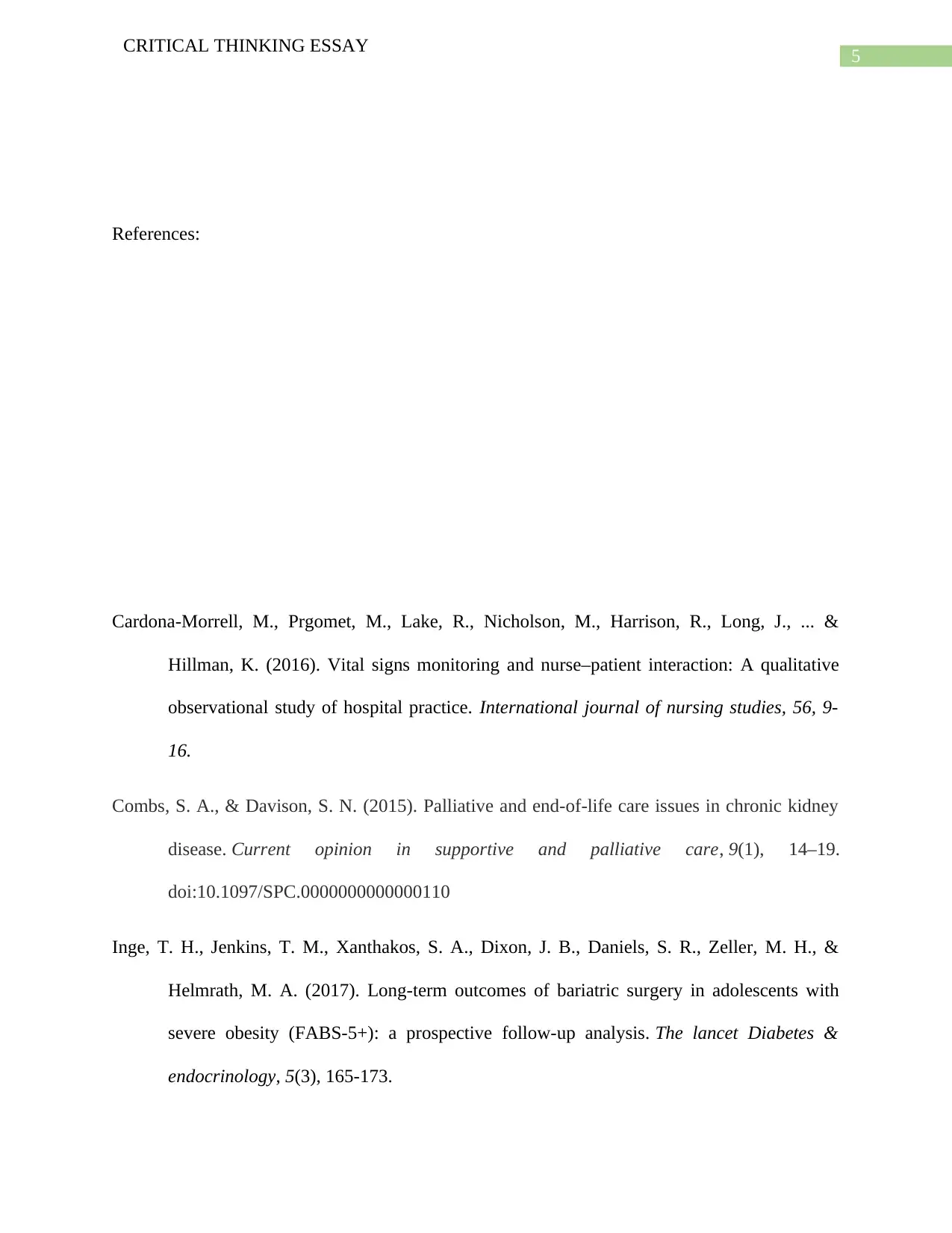
5
CRITICAL THINKING ESSAY
References:
Cardona-Morrell, M., Prgomet, M., Lake, R., Nicholson, M., Harrison, R., Long, J., ... &
Hillman, K. (2016). Vital signs monitoring and nurse–patient interaction: A qualitative
observational study of hospital practice. International journal of nursing studies, 56, 9-
16.
Combs, S. A., & Davison, S. N. (2015). Palliative and end-of-life care issues in chronic kidney
disease. Current opinion in supportive and palliative care, 9(1), 14–19.
doi:10.1097/SPC.0000000000000110
Inge, T. H., Jenkins, T. M., Xanthakos, S. A., Dixon, J. B., Daniels, S. R., Zeller, M. H., &
Helmrath, M. A. (2017). Long-term outcomes of bariatric surgery in adolescents with
severe obesity (FABS-5+): a prospective follow-up analysis. The lancet Diabetes &
endocrinology, 5(3), 165-173.
CRITICAL THINKING ESSAY
References:
Cardona-Morrell, M., Prgomet, M., Lake, R., Nicholson, M., Harrison, R., Long, J., ... &
Hillman, K. (2016). Vital signs monitoring and nurse–patient interaction: A qualitative
observational study of hospital practice. International journal of nursing studies, 56, 9-
16.
Combs, S. A., & Davison, S. N. (2015). Palliative and end-of-life care issues in chronic kidney
disease. Current opinion in supportive and palliative care, 9(1), 14–19.
doi:10.1097/SPC.0000000000000110
Inge, T. H., Jenkins, T. M., Xanthakos, S. A., Dixon, J. B., Daniels, S. R., Zeller, M. H., &
Helmrath, M. A. (2017). Long-term outcomes of bariatric surgery in adolescents with
severe obesity (FABS-5+): a prospective follow-up analysis. The lancet Diabetes &
endocrinology, 5(3), 165-173.
⊘ This is a preview!⊘
Do you want full access?
Subscribe today to unlock all pages.

Trusted by 1+ million students worldwide
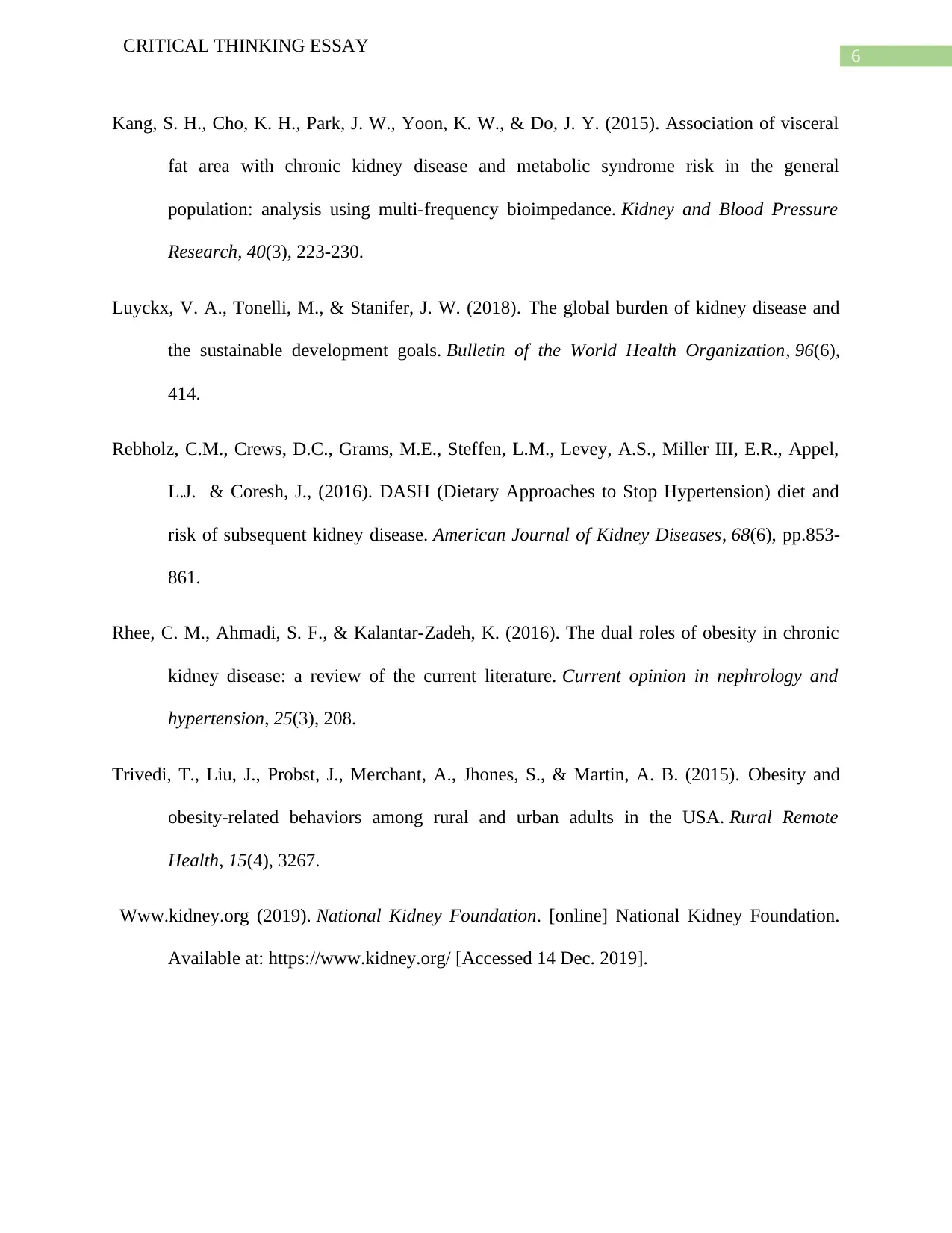
6
CRITICAL THINKING ESSAY
Kang, S. H., Cho, K. H., Park, J. W., Yoon, K. W., & Do, J. Y. (2015). Association of visceral
fat area with chronic kidney disease and metabolic syndrome risk in the general
population: analysis using multi-frequency bioimpedance. Kidney and Blood Pressure
Research, 40(3), 223-230.
Luyckx, V. A., Tonelli, M., & Stanifer, J. W. (2018). The global burden of kidney disease and
the sustainable development goals. Bulletin of the World Health Organization, 96(6),
414.
Rebholz, C.M., Crews, D.C., Grams, M.E., Steffen, L.M., Levey, A.S., Miller III, E.R., Appel,
L.J. & Coresh, J., (2016). DASH (Dietary Approaches to Stop Hypertension) diet and
risk of subsequent kidney disease. American Journal of Kidney Diseases, 68(6), pp.853-
861.
Rhee, C. M., Ahmadi, S. F., & Kalantar-Zadeh, K. (2016). The dual roles of obesity in chronic
kidney disease: a review of the current literature. Current opinion in nephrology and
hypertension, 25(3), 208.
Trivedi, T., Liu, J., Probst, J., Merchant, A., Jhones, S., & Martin, A. B. (2015). Obesity and
obesity-related behaviors among rural and urban adults in the USA. Rural Remote
Health, 15(4), 3267.
Www.kidney.org (2019). National Kidney Foundation. [online] National Kidney Foundation.
Available at: https://www.kidney.org/ [Accessed 14 Dec. 2019].
CRITICAL THINKING ESSAY
Kang, S. H., Cho, K. H., Park, J. W., Yoon, K. W., & Do, J. Y. (2015). Association of visceral
fat area with chronic kidney disease and metabolic syndrome risk in the general
population: analysis using multi-frequency bioimpedance. Kidney and Blood Pressure
Research, 40(3), 223-230.
Luyckx, V. A., Tonelli, M., & Stanifer, J. W. (2018). The global burden of kidney disease and
the sustainable development goals. Bulletin of the World Health Organization, 96(6),
414.
Rebholz, C.M., Crews, D.C., Grams, M.E., Steffen, L.M., Levey, A.S., Miller III, E.R., Appel,
L.J. & Coresh, J., (2016). DASH (Dietary Approaches to Stop Hypertension) diet and
risk of subsequent kidney disease. American Journal of Kidney Diseases, 68(6), pp.853-
861.
Rhee, C. M., Ahmadi, S. F., & Kalantar-Zadeh, K. (2016). The dual roles of obesity in chronic
kidney disease: a review of the current literature. Current opinion in nephrology and
hypertension, 25(3), 208.
Trivedi, T., Liu, J., Probst, J., Merchant, A., Jhones, S., & Martin, A. B. (2015). Obesity and
obesity-related behaviors among rural and urban adults in the USA. Rural Remote
Health, 15(4), 3267.
Www.kidney.org (2019). National Kidney Foundation. [online] National Kidney Foundation.
Available at: https://www.kidney.org/ [Accessed 14 Dec. 2019].
Paraphrase This Document
Need a fresh take? Get an instant paraphrase of this document with our AI Paraphraser

7
CRITICAL THINKING ESSAY
CRITICAL THINKING ESSAY
1 out of 8
Related Documents
Your All-in-One AI-Powered Toolkit for Academic Success.
+13062052269
info@desklib.com
Available 24*7 on WhatsApp / Email
![[object Object]](/_next/static/media/star-bottom.7253800d.svg)
Unlock your academic potential
Copyright © 2020–2025 A2Z Services. All Rights Reserved. Developed and managed by ZUCOL.





